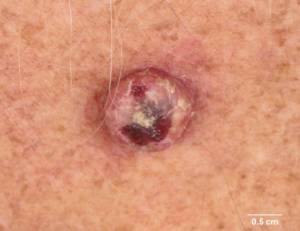Study finds ways to reduce the risk of common Queensland skin tumour
New QIMR Berghofer research has found limiting sun exposure, quitting smoking and cutting down on alcohol could help Queenslanders avoid developing the common skin tumour keratoacanthoma (KA).

The study findings have been published in the journal JAMA Dermatology.
Keratoacanthoma tumours develop on areas of the body commonly exposed to the sun, including the legs, arms and hands. They usually do not cause death, but can pose a diagnostic dilemma to doctors because they look similar to squamous cell carcinomas (SSCs).
It is estimated about 5000 Queenslanders, aged 20 years or older, develop keratoacanthomas each year.
Senior study author and researcher in QIMR Berghofer’s Cancer Control Group Associate Professor Catherine Olsen said the skin lesions were very common among Queenslanders because of the state’s sunny climate.
“Our study aimed to learn more about these common skin tumours because while they don’t usually pose a serious health risk to patients, testing and removal of the tumours come at a considerable cost to Queensland’s health service,” Associate Professor Olsen said.
“A number of the key risk factors for these tumours include high levels of sun exposure, fair skin, smoking, and high alcohol use. Most of these are modifiable behaviours, and if Queenslanders protected themselves better against the sun, stopped smoking and drank within the recommended alcohol guidelines, we could potentially see a drop in these skin tumours.
“This research also builds on our growing understanding of the biology of skin cancers and conditions, and will hopefully help inform future advice on how we can protect our skin.”
First author and QIMR Berghofer Cancer Control group researcher Dr Magdalena Claeson, who is also a practicing dermatologist, said keratoacanthomas are almost always removed or treated.
“Keratoacanthomas develop on sun damaged skin and it’s often difficult to distinguish them from more sinister skin cancers, so doctors tend to recommend medical intervention,” Dr Claeson said.
“They can grow quickly and reach 10 to 20 millimetres in diameter in a matter of weeks or a few months. They can also look frightening, even though we know they aren’t usually dangerous like melanomas.
“The medical profession doesn’t really know a lot about keratoacanthomas. We don’t know what the specific biological mechanisms are that lead to these lesions, why they grow so quickly, and we definitely don’t understand why some tumours can resolve spontaneously! Our study has at least provided information that the risk factors for KA are quite similar to those for other skin cancers, and that has not been shown confidently before.”
The main risk factors for keratoacanthoma include fair skin, freckles and an inability to tan; high levels of sun exposure and sunburn before the age of 10; smoking and the consumption of 14 or more alcoholic drinks a week. Men and all people aged over 60 years are also at greater risk than the general population.
The researchers used data from the QIMR Berghofer-led QSkin study, which is the largest research study ever conducted on skin cancer.
They examined data on skin tumours diagnosed in 40,438 Queenslanders between 2010 and 2014.
The research was primarily funded by the National Health and Medical Research Council of Australia.
The study findings can be accessed on the JAMA Dermatology website (DOI 200060).
Sun protection advice: Stay out of the sun when the UV index is high, seek shade, cover up with clothing, put on a broad-brimmed hat, use sunscreen, and wear sun glasses.
Pronunciation: keratoacanthoma – KERAH-toh-AK-an-thoh-mah
Media: To organise an interview with Associate Professor Catherine Olsen or Dr Magdalena Claeson please contact Gail Burke on 0427 179 216 or email Gail.Burke@QIMRBerghofer.edu.au.




